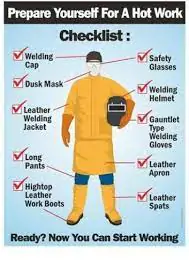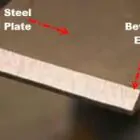Welding puts everyone in the same health and safety dangers, such as dangerous fumes, fires, or explosions. We can stay safe in the workshop and avoid accidents and injuries if we follow the best welding safety rules and use the right safety gear.
Here are 10 ways you can improve the safety of your welding:
1. Figure out the dangers and limits of your welding job
Depending on the welding job we’re going to do, we’ll need to check different things based on the risks. However, in general, the best ways to start welding are to have good ventilation, use the right tools in the best possible conditions, and work with less dangerous materials. In the end, we’ll have to keep an eye on the air in the work area and make sure we don’t go over the recommended limits.
2. Read the owner’s manual and ask to be shown how to use it
Manufacturers’ instructions are always the best safety tips, so we should read the welder’s operating manual to make sure we’re using it safely and to get the most out of it.
Also, all welders should be taught how to use equipment, do their jobs, and handle emergencies in a safe way.
3. Protect yourself
Safe welders protect themselves from all of the potentially harmful effects of arc welding by always wearing the right gear. This includes fire-resistant personal protective clothing like denim pants and a welding jacket, as well as helmets, goggles, and other eye protection with special filter lenses or plates.
Don’t forget to bring your shoes. High-top leather shoes or boots are the best way to protect your feet. Don’t wear tennis shoes or shoes you wear around the house.
4. Breathe well
One of the main health risks is the smoke and fumes that come out of welding. Use an exhaust hood to get rid of fumes and make sure there is enough clean air to breathe. When welding certain materials, you need to wear a respirator.
5. Don’t look at the light
When it comes to welding, our eyes are the most sensitive part of our body, and a “arc flash” is one of the most common ways to hurt our eyes. It only takes a moment for the rays from a welding arc to cause this painful condition in eyes that aren’t covered.
Arc flash is a burn on the outer layer of the eye caused by the intense ultraviolet radiation from electric welding arcs. Pain might not show up until hours later.
This is one reason why it’s important to choose the right helmet.
6. Medical care
Depending on the type of welding you do, you may need to have your lungs, skin, eyes, heart, and hearing checked regularly by a doctor.
7. Avoid repetitive stress injuries
RSI, or repetitive stress injuries, are a safety risk in almost every job. In industries that can be dangerous, like welding, they are even more important. As a general rule, you can avoid RSI by keeping good posture at work and taking breaks from long, repetitive tasks. When it comes to welding, these breaks are even more important. Welders need to be at their best when they do a weld.
8. Be careful not to get electrocuted
Even though it’s common to get small electric shocks when welding, it shouldn’t happen too often. Make sure the equipment is in good shape and dry to avoid getting an electric shock. Using good safety gear is the best way to avoid getting an electric shock, which is especially important when welding in damp places.
9. Don’t have a messy work area
When it comes to welding, workplace order is even more important to avoid mistakes and dangers like burns or electric shock. But these aren’t the only things that could go wrong. Just think about what could go wrong if you use the wrong electrode in a weld or if your equipment settings don’t match the WPS you should be following.
10. Wear shoes or boots that aren’t made of metal
Normal shoes aren’t made to handle red-hot sparks or slag, and they could even put you and your coworkers in danger. Make sure you’re wearing welding boots that don’t conduct electricity when you’re in the welding shop. This is the best way to keep from getting burned or shocked by electricity.
Welding is a dangerous job, and learning how to do it can be even more dangerous. Luckily, people who work on technology have made different ed-tech solutions to help teach skills like welding in a way that is safer and more sustainable.





